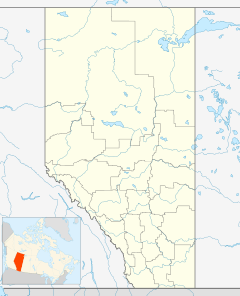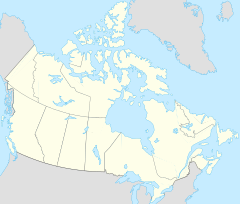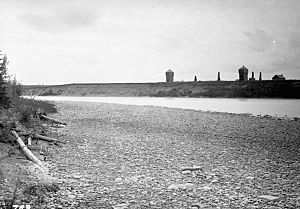Rocky Mountain House facts for kids
Quick facts for kids
Rocky Mountain House
|
||
|---|---|---|
|
Town
|
||
| Town of Rocky Mountain House | ||
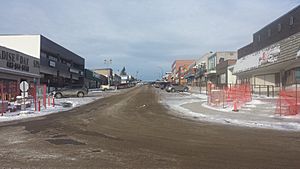
Downtown Rocky Mountain House (2014)
|
||
|
||
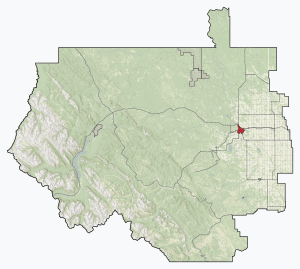
Location in Clearwater County
|
||
| Country | Canada | |
| Province | Alberta | |
| Region | Central Alberta | |
| Census division | 9 | |
| Municipal district | Clearwater County | |
| Founded | 1799 | |
| Incorporated | ||
| • Village | May 15, 1913 | |
| • Town | August 31, 1939 | |
| Area
(2021)
|
||
| • Land | 13.05 km2 (5.04 sq mi) | |
| Elevation | 985 m (3,232 ft) | |
| Population
(2021)
|
||
| • Total | 6,765 | |
| • Density | 518.3/km2 (1,342/sq mi) | |
| Time zone | UTC−07:00 (MST) | |
| • Summer (DST) | UTC−06:00 (MDT) | |
| Forward sortation area |
T4T
|
|
| Area code(s) | 403 / 587 / 368 / 825 | |
| Highways | ||
| Waterways | North Saskatchewan River, Clearwater River | |
Rocky Mountain House is a town in west-central Alberta, Canada. It's about 77 km (48 mi) west of Red Deer. The town is located where the Clearwater River meets the North Saskatchewan River. It's also at the crossing of two main roads: Highway 22 (called the Cowboy Trail) and Highway 11 (the David Thompson Highway). The main office for Clearwater County is found here.
Contents
History of Rocky Mountain House

The town of Rocky Mountain House has a long and interesting history. It dates back to the late 1700s. At that time, British and Canadian fur traders were moving west across Canada.
In 1799, two big fur trading companies, the Hudson's Bay Company and the North West Company, set up trading posts here. These posts were called Rocky Mountain House and Acton House. They traded with the local Indigenous peoples. The companies later joined together in 1821. They kept trading until 1875, when the Rocky Mountain House post finally closed. But the name of the settlement stayed.
Rocky Mountain House was also a starting point for many explorers. One famous explorer was David Thompson. He was looking for a way to cross the mountains to the Pacific Ocean. Many travelers used this spot as a stop on their journey further west or northwest. People still do today!
In the early 1900s, more people came to the area. They were looking for good farmland and lots of natural resources. Rocky Mountain House became a well-known town by 1912. Many of the early settlers in this region were from Scandinavian countries.
On October 20, 2021, the town felt a magnitude 5.0 earthquake. It happened just after 9:20 PM. This was the second-strongest earthquake ever recorded in Alberta.
The Fur Trade Era
Rocky Mountain House and Acton House were important fur trading posts. They operated from 1799 to 1876. Rocky Mountain House belonged to the North West Company (NWC). Acton House belonged to the Hudson's Bay Company (HBC). When these two companies merged in 1821, the name Rocky Mountain House was kept. These posts opened and closed seven times over the years.
Rocky Mountain House was the most western trading post on the North Saskatchewan River. You could even see the Rocky Mountains from there. The fort helped traders connect with the Blackfeet and Piegans. It also allowed trade with the Kootenays who lived across the mountains. The Blackfeet and Piegans often stopped the Kootenays from reaching Fort Edmonton. They wanted to be the middlemen and control who got guns.
The fort was also a base for explorers trying to find a way through the Rocky Mountains. Besides trading, the post made pemmican (a type of dried meat) and York boats (large boats used for transport).
The posts were built where the Clearwater River flows into the North Saskatchewan River. They were on the north bank, just above the Clearwater. They were built strongly to protect against attacks. Today, there's an interpretive center at this historic spot.
Geography and Climate
Rocky Mountain House is bordered by the North Saskatchewan River to the west. This is where the Clearwater River joins the North Saskatchewan River.
Crimson Lake is a lake about 17 km (11 mi) northwest of town. This lake is part of Crimson Lake Provincial Park.
What is the Climate Like?
Rocky Mountain House has a cool climate. It's known as a subarctic climate (Köppen climate classification Dfc), but it's also very close to a humid continental climate (Köppen Dfb). This means that while daytime temperatures can be mild, the nights are often very cold, leading to frequent frosts. Even in January, the average high temperature is around −4 °C (25 °F). This is much milder than other cold areas in Canada that are further east.
The hottest temperature ever recorded in Rocky Mountain House was 35.0 °C (95 °F) on July 23, 1928. The coldest temperature ever recorded was a very chilly −55.6 °C (−68 °F) on February 12, 1936.
| Climate data for Rocky Mountain House Airport, 1981–2010 normals, extremes 1915–present | |||||||||||||
|---|---|---|---|---|---|---|---|---|---|---|---|---|---|
| Month | Jan | Feb | Mar | Apr | May | Jun | Jul | Aug | Sep | Oct | Nov | Dec | Year |
| Record high °C (°F) | 15.7 (60.3) |
19.0 (66.2) |
22.5 (72.5) |
27.8 (82.0) |
34.4 (93.9) |
33.9 (93.0) |
35.0 (95.0) |
32.8 (91.0) |
32.8 (91.0) |
30.6 (87.1) |
23.3 (73.9) |
17.8 (64.0) |
35.0 (95.0) |
| Mean daily maximum °C (°F) | −3.3 (26.1) |
−1.5 (29.3) |
3.2 (37.8) |
10.8 (51.4) |
16.2 (61.2) |
19.3 (66.7) |
21.1 (70.0) |
21.1 (70.0) |
16.0 (60.8) |
10.8 (51.4) |
0.6 (33.1) |
−3.5 (25.7) |
9.2 (48.6) |
| Daily mean °C (°F) | −10.3 (13.5) |
−8.6 (16.5) |
−3.2 (26.2) |
3.7 (38.7) |
9.0 (48.2) |
12.7 (54.9) |
14.5 (58.1) |
14.2 (57.6) |
8.8 (47.8) |
3.7 (38.7) |
−5.7 (21.7) |
−10.2 (13.6) |
2.4 (36.3) |
| Mean daily minimum °C (°F) | −17.2 (1.0) |
−15.8 (3.6) |
−9.6 (14.7) |
−3.5 (25.7) |
1.7 (35.1) |
6.1 (43.0) |
8.0 (46.4) |
7.2 (45.0) |
1.5 (34.7) |
−3.5 (25.7) |
−12 (10) |
−16.9 (1.6) |
−4.5 (23.9) |
| Record low °C (°F) | −53.9 (−65.0) |
−55.6 (−68.1) |
−44.4 (−47.9) |
−33.9 (−29.0) |
−15.6 (3.9) |
−11.1 (12.0) |
−6.7 (19.9) |
−11.7 (10.9) |
−16.7 (1.9) |
−30.1 (−22.2) |
−40 (−40) |
−53.9 (−65.0) |
−55.6 (−68.1) |
| Average precipitation mm (inches) | 19.1 (0.75) |
15.2 (0.60) |
18.0 (0.71) |
23.9 (0.94) |
65.2 (2.57) |
86.6 (3.41) |
114.6 (4.51) |
67.3 (2.65) |
73.8 (2.91) |
25.9 (1.02) |
17.3 (0.68) |
15.9 (0.63) |
542.8 (21.37) |
| Average rainfall mm (inches) | 0.2 (0.01) |
0.6 (0.02) |
1.3 (0.05) |
12.5 (0.49) |
52.4 (2.06) |
86.6 (3.41) |
114.6 (4.51) |
67.3 (2.65) |
68.5 (2.70) |
13.3 (0.52) |
1.6 (0.06) |
0.4 (0.02) |
419.6 (16.52) |
| Average snowfall cm (inches) | 26.2 (10.3) |
21.5 (8.5) |
25.7 (10.1) |
14.3 (5.6) |
12.8 (5.0) |
0.02 (0.01) |
0.0 (0.0) |
0.0 (0.0) |
5.7 (2.2) |
14.7 (5.8) |
21.8 (8.6) |
22.8 (9.0) |
165.1 (65.0) |
| Source: Environment Canada | |||||||||||||
Population and Economy
How Many People Live Here?
In 2021, the Town of Rocky Mountain House had a population of 6,765 people. These people lived in 2,693 homes. This was a small increase from its population of 6,635 in 2016. The town covers a land area of 13.05 km2 (5.04 sq mi).
What is the Economy Like?
The economy in the Rocky Mountain House area is mainly based on a few key industries:
- Petroleum: This involves finding and using oil and gas.
- Agriculture: This means farming and raising animals.
- Forestry: This is about managing forests and using wood products.
Tourism is also important for the town's economy. This is because of its location at the crossing of Highway 22 and Highway 11. It's also halfway between Red Deer and the beautiful Alberta's Rockies region. This makes it a popular stop for travelers.
Transportation and Sports
How Do People Get Around?
For road travel, Rocky Mountain House is connected by Highway 22 and Highway 11.
If you're flying, the town has its own airport, the Rocky Mountain House Airport.
What Sports Can You Play?
The Recreation, Parks & Community Services Department in Rocky Mountain House organizes five sports tournaments each year. These include:
- Two slo-pitch (softball) tournaments
- One sno-pitch tournament (like slo-pitch, but in the snow!)
- One volleyball tournament
- One combined hockey and slo-pitch tournament
International Connections
Rocky Mountain House has a "twin town" relationship with Kamikawa, Hokkaido, in Japan. This means they share cultural and friendly ties.
See also
 In Spanish: Rocky Mountain House para niños
In Spanish: Rocky Mountain House para niños



